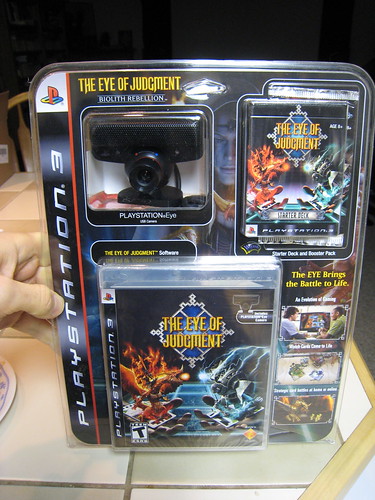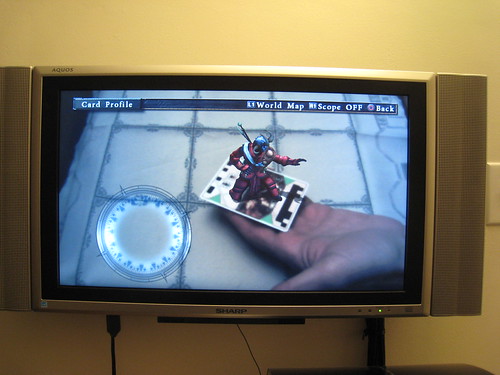I recently got Eye of Judgement for the Playstation 3. Actually, it’s the only game disc I own for the PS3 – I bought a few small downloadable games, but Eye of Judgement is the first “real” game I bought.
Eye of Judgement interested me for a few reasons:
- It’s a card game along the lines of Magic, also by Wizards of the Coast
- It uses augmented reality in a mass-market game
- It comes with the Playstation Eye, the PS3 webcam
First off, the bundle:
On Amazon, it’s $45 for the game, which comes bundled with the Playstation Eye (PSeye). $45 for a game and a webcam is pretty cheap. I think if you buy the webcam by itself, it’s $30. It comes with the game, PSeye, game mat, stand for the PSeye, starter deck, and one booster pack.

Probably the reason the whole thing is so cheap is they expect to make it up in booster pack sales. As with Magic: the Gathering, it’s all about getting a bunch of good cards, and building a deck from them that works well. Booster packs are pretty pricey, $4 for 8 cards.
The setup:
You assemble the stand, attach the PSeye to the stand, plug the PSeye into the PS3, and lay the game mat under the PSeye. You want a well-lit area, since the primary premise here is that the PSeye can see which cards are being played, and have the game react accordingly.
This setup is easy enough in my bedroom, but if I ever want to set it up in my living room, I’ll have to hook up some kind of powered USB extension to reach across the room to the coffee table.
The basic operation:
The cards have two main features, as far as the PSeye is concerned: oversized black bars at the top and bottom of the card, and green triangles on the sides of the card. The black bars act as an oversized barcode to let the PS3 determine which card it is, and the green triangles allow the PS3 to know the orientation of the card.
There is a test mode, where you can hold a card and view it as a rendered pop-up. It shows the video feed from the PSeye, with a 3D model of the monster from that card overlayed on the video feed, scaled and rotated so it appears to be standing on the card. You can move and rotate the card and the 3D model updates reasonably quickly. You can tilt the card slightly from side to side, but since the marks on the card have to be clearly in camera, you can’t tilt it that far.

This test mode is the most traditional use of augmented reality, but in actual gameplay the entire video feed is covered, so isn’t such direct AR.
The game:
The game is played on the 3×3 grid of the game mat. The object is to have a creature card in 5 of the 9 squares at the end of your turn (thus controlling a majority of the board). Since there are only 9 potential places to play, the game play is much shorter and more strategic than a game of Magic, which could easily last over an hour. Typical Eye of Judgement games last about 20 minutes, though that’s just an estimate, I didn’t actually time them.
I won’t go into all the details of gameplay, but it’s very strategic. Each square has a type, and each card has a type, so where you play the card is very important. Creatures also have strong sides and weak sides, so the direction the card is facing when you play it is important as well.
So far, I pretty much suck. I’m playing against the computer on the easiest setting, and most of the time I lose. However, I only just started playing, so hopefully after some practice I’ll suck a lot less. =)
[ UPDATE ]
I just noticed the price on Amazon has gone from $45 to $65… not as great a deal, but still not too bad for a game and a webcam.

